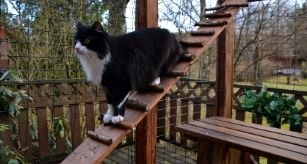Cats are highly valued companion pets in thousands of Australian households. Cats are an excellent companion and when properly cared for, they fit in very well to our family and community life, providing pleasure and company for many people. However, when things go wrong, uncared for cats suffer unnecessarily, are a nuisance in our neighbourhoods, represent a health risk and can do very serious damage to our fauna.
Not everyone loves cats, especially if the neighbourhood is occupied by many cats. Whether cats are owned, semi-owned or stray and feral, they can cause problems by roaming onto neighbours’ properties, attacking other cats, harming wildlife, yowling loudly, defecating in gardens and children’s sand pits or spraying to mark territory.
Residents are entitled to enjoy their garden without cats roaming onto the property. Cats are not permitted on private property without permission, or to cause a nuisance. Cats - whether owned, semi-owned or stray and feral - wandering and trespassing on a neighbour’s property can:
- Cause damage to garden beds by defecating and digging
- Create health concerns in children's sandpits
- Cause undue noise and injuries and cause owners to receive expensive vet bills due to fighting with owned or stray cats
- Call and cry when seeking a mate
- Spray offensively on front doors, mats and other areas
- Attack and kill wildlife.
Council receives many complaints from residents who have experienced any or all of the above and are asking for assistance.
For information on how to care for your cat and to minimise it being a nuisance, visit:
Residents who have concerns about a cat’s nuisance behaviour should first try approaching the cat’s owner in an amicable manner. The owner may not be aware of the cat’s behaviour and will then be in a position to address concerns. This often avoids the need for expensive legal proceedings that are often time consuming and damaging to neighbourly relations.
If your cat is found wandering off your property and is not identified it can be seized and impounded. You may have to pay a fine when reclaiming your cat from the Council pound. If your cat is caught and taken to the Council pound, you will be contacted using information from your cat's registration tag or microchip. Your cat can be collected after paying a release fee and you may receive a fine.
If the cat is not micro-chipped the cat will be left for the pound to re-home.
Trapping Cats
Council has humane traps available for use by residents experiencing problems with un-owned or feral cats, or cats deemed to be a nuisance after Council has issued a Notice of Objection. These cages are not for cats that are owned or registered. Trapped cats will be collected between 8.30am to 4.30pm Monday to Friday. Contact Council on 9262 6333 for further information regarding the use of humane containment traps.
Under the Domestic Animals Act 1994, residents of a property can trap or seize a cat if it has roamed onto their property more than once without permission. Residents may request a cat trap from Council for a two week period which may be extended if necessary.
Cats Repeatedly Roaming onto Neighbouring Properties
If your cat (even if it has identification) wanders onto another person's property more than once, it may be seized and impounded. The neighbour has the right to contain a cat and hand it to Council. Once it has been established that the same cat is re-offending, Council may issue a Notice of Objection to the cat owner objecting to the presence of that cat being on the property. Objecting neighbours need to know that if a Notice of Objection is issued their address will be made known to the cat owner.
If, after the owner receives a Notice of Objection, the cat continues to cause a nuisance and continues to enter the property, Council can issue fine/s to the cat owner and may impound the cat. A signed statement or witnessed Statutory Declaration may need to be supplied to Council by the affected resident.
For Council to take enforcement action against a cat that is continually trespassing, and, if the owner cannot be identified, the cat will need to be trapped and given to Council on more than one occasion.
Feeding Unowned and Feral Cats
There are millions of unowned stray and feral cats in Australia. The cat overpopulation problem is due to a number of factors, such as supply exceeding demand and the ability of cats to breed extremely quickly. Research has also found that a major contributing factor to this problem is people feeding un-owned cats but not taking full ownership or responsibility for them.
People feed un-owned cats because they genuinely care about them, and feel sorry for them. However many people don't realise that they are causing a bigger problem by feeding, but not owning (e.g. de-sexing and identifying) these cats. Feeding un-owned cats helps keep them alive and strong enough to reproduce. They keep breeding more and more kittens into a life of disease and neglect. This contributes to the tragic cat overpopulation problem in Australia.
Thousands of cats are impounded, and the majority of these have to be euthanased (put to sleep). This is mainly due to poor health or because not enough homes can be found for them.
Feeding unowned cats isn't the answer. If you want to help you must either take ownership of the cat or phone Council to have the cat taken to the pound or shelter.
More Information
- RSPCA or call 9224 2222
- Cat Protection Society or call 8457 6500
- Agriculture Victoria - Cats








